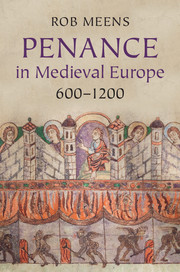Book contents
- Frontmatter
- Dedication
- Contents
- List of Figures
- Acknowledgments
- 1 Introduction
- 2 The late antique legacy
- 3 A new beginning? Penitential practice in the insular world
- 4 Insular texts on the move: penance in Francia and England
- 5 Penance and the Carolingian Reforms
- 6 New penitential territories: the tenth and eleventh centuries
- 7 The twelfth century
- Conclusion
- Appendix 1 The manuscripts of Theodore’s penitential
- Appendix 2 The manuscripts of the Excarpsus Cummeani
- Appendix 3 The manuscripts of the Bede and Egbert penitentials
- Appendix 4 The manuscripts of Halitgar’s penitential
- Sources
- Bibliography
- General index
- Manuscript index
- References
2 - The late antique legacy
Published online by Cambridge University Press: 05 August 2014
- Frontmatter
- Dedication
- Contents
- List of Figures
- Acknowledgments
- 1 Introduction
- 2 The late antique legacy
- 3 A new beginning? Penitential practice in the insular world
- 4 Insular texts on the move: penance in Francia and England
- 5 Penance and the Carolingian Reforms
- 6 New penitential territories: the tenth and eleventh centuries
- 7 The twelfth century
- Conclusion
- Appendix 1 The manuscripts of Theodore’s penitential
- Appendix 2 The manuscripts of the Excarpsus Cummeani
- Appendix 3 The manuscripts of the Bede and Egbert penitentials
- Appendix 4 The manuscripts of Halitgar’s penitential
- Sources
- Bibliography
- General index
- Manuscript index
- References
Summary
We begin in the year 590 in Rome. At this moment the situation in the former capital of the world can be characterized as simply disastrous. Justinian’s attempt to reconquer the western parts of the Roman empire, which started with the destruction of the Vandal kingdom in northern Africa in 533, resulted in Italy in the Gothic Wars. This prolonged confrontation between the troops of the Byzantine generals Belisarius and Narses and the Gothic armies in Italy brought an end to the economic prosperity of the Italian peninsula. Whereas under Gothic rule late Roman structures had continued to function, the Gothic Wars put a definitive end to the prosperity of late antique Italy, leading to famine and plague. In November 589 the waters of the Tiber had risen to such heights that buildings collapsed and ecclesiastical granaries were destroyed. Great amounts of grain had been lost while people were seeing snakes and dragons swimming in the river. In January the plague hit hard, Pope Gelasius II being among its first casualties. The people of Rome looked for guidance to a former prefect of the city, a member of a distinguished Roman family living on the Coelian Hill, the same family from which Pope Felix III (483–92) had come. Gregory the Great, as the scion of this family later came to be known, came to the papal office with serious reservations as he had chosen the contemplative life and was now forced to return to the sorrows of the active life again. His fame, however, seems to have spread fast. Soon after he had become the new bishop of Rome, his namesake, Bishop Gregory of Tours, included an account of Gregory’s election in his Histories. The bishop of Tours relates that he was informed about Roman affairs by a deacon who had travelled to Rome in that year, bringing back relics to the town of Tours. Gregory’s account informs us of the catastrophes in Rome and the way the newly elected pope tried to remedy them. The new pope saw the plague as a divine punishment for the sins of the people in Rome and organized a penitential procession to atone for these sins.
- Type
- Chapter
- Information
- Penance in Medieval Europe, 600–1200 , pp. 12 - 36Publisher: Cambridge University PressPrint publication year: 2014
References
- 1
- Cited by



